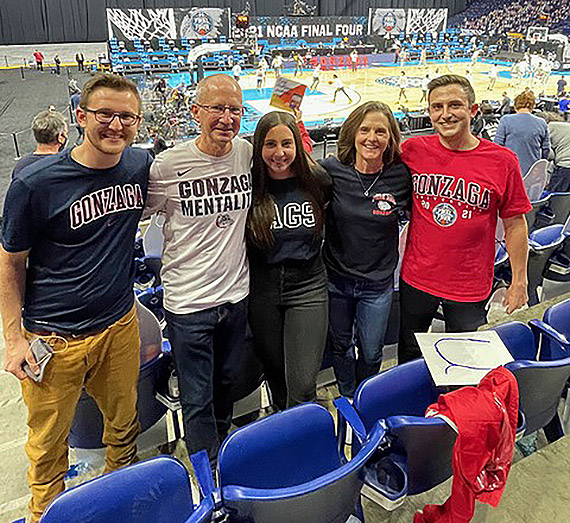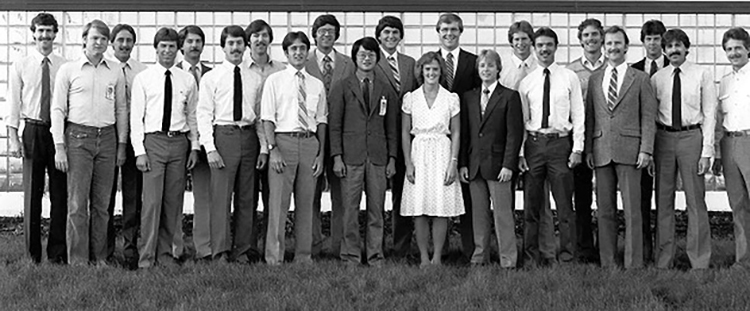Introducing the John and Joan Bollier Family Center for Integrated Science and Engineering

SPOKANE, Wash. — Gonzaga University’s new Integrated Science and Engineering facility, which opens this fall, will be named the John and Joan Bollier Family Center for Integrated Science and Engineering — recognizing the family’s commitment to helping all students pursue careers in science, technology, engineering, and mathematics (STEM). The Bollier family of Newberg, Oregon, has generously provided a significant donation for the $49.7 million facility that will inspire a new generation of professionals.
Four of the five Bollier family members are engineers — in addition to John and Joan, their sons Brett (’13) and Nolan (Gonzaga-in-Florence ’15) have degrees in mechanical engineering from Gonzaga and Marquette, respectively, while daughter Emily (’15) is a graduate of Gonzaga’s School of Business Administration.
An Impact for 'Generations to Come’
Gonzaga President Thayne M. McCulloh, D.Phil., expressed profound gratitude for the gift:
“The Bollier family exemplifies the values, commitment, and spirit of this community. John, Joan, Brett, Emily, and Nolan’s thoughtful and generous leadership makes a significant difference in ensuring the University delivers on its mission,” President McCulloh said. “Because of the Bolliers, Gonzaga’s commitment to Jesuit STEM education and research will have an impact on the Inland Northwest and beyond for generations to come. I am truly thankful for the support and Zag spirit with which they show up each day.”
Heralding a new era of rapid expansion in STEM-related educational and interdisciplinary collaboration, the facility will foster innovation and entrepreneurship, exemplary teaching and undergraduate research — enabling faculty and students to conduct important theoretical and applied work. In September, faculty and staff will begin moving into their offices and students will begin using its common areas, study spaces and labs; classes are expected to begin in spring semester 2022.
An unwavering belief in the importance of STEM education and its myriad career paths, the Bolliers want to help Gonzaga affirm the interest of young people in STEM fields.
A Desire to Help Students Succeed
“No one told me engineering would be hard,” said Joan Bollier, recalling how her adolescent interest in math evolved into a civil engineering major in college. “Nobody told me it was unusual for a woman to be a civil engineer or that I couldn’t do it. I just went to school and started studying.”
John referenced a photograph of Joan taken during her graduate engineers’ program at Lockheed after she earned her degree from Oregon State University in 1983. Front and center in a white dress, she’s the only woman among 19 male engineers.
“Every single student can succeed,” emphasized Joan.

John also grew up with an aptitude and interest in STEM disciplines.
“If it involved math or science, I was all over it,” said John, who, as a teenager, inherited a 1941 Plymouth, which he restored and parlayed into a lifelong hot rod hobby. He genuinely enjoys hands-on work.
John earned a degree in construction engineering management at Sacramento State University before taking an internship with Stacy and Witbeck, Inc., (SWI) the company he recently retired from as CEO after 35 years of building rail lines nationwide. He still serves as chair of SWI’s board.
Joan and John met while working on a light rail project in San Jose, California. Joan went on to run the engineering division of the public works department for the city of Campbell, California, for five years, when their first two children, Brett, and Emily were born.
John’s work with SWI took the family to Oregon near the area where Joan had grown up. She retired from engineering to stay home with their children, and the family grew with the birth of Nolan in 1995.
The Bolliers are grateful to be able to make a difference and view philanthropy as a natural reflex.
“We had the ability to help others,” Joan said, “so how could we not?”
John added, “We never thought we’d have the opportunity to do the same thing that others did for us. It’s great to be able to give to organizations that serve.”
The family’s connection with Gonzaga began when Brett and Emily were students and Joan would bring her mother to Spokane for Gonzaga basketball games. Over the years, the family drew remarkably close with the Gonzaga community.
“Everyone has been so friendly and welcoming,” said John, who has served on the Gonzaga University Board of Regents since 2018. “We feel right at home.”
In addition to the Bollier Center gift, the family has supported Gonzaga athletics and scholarships. John and Joan are also excited about the impact that the University and its students are having through the Opportunity Northeast (ONE) initiative and the chance to be involved in something so beneficial to the lives of families in Gonzaga’s neighborhood.
About the Center
The John and Joan Bollier Family Center for Integrated Science and Engineering adds more than 82,000 square-feet of space dedicated to student learning in the sciences, technology, engineering, and mathematics on Gonzaga’s campus, with special focus on providing opportunities for cross-disciplinary collaboration. In a visual statement to interdisciplinarity, skybridges connect the facility with Gonzaga’s PACCAR Center for Applied Science and to the College of Arts and Sciences’ chemistry and biology departments located in Hughes Hall. The PACCAR Center is connected via skybridge to the Herak Center for Engineering. Students of all majors will experience the Bollier Center through core curriculum classes. Additionally, the Bollier Center will allow students to engage in integrated environments to solve problems, create commerce, and explore disciplines of innovation and entrepreneurship — all balanced with a heart and mind for the common good. Gonzaga aims for the facility to meet the regulations required for a LEED (Leadership in Energy and Environmental Design) Silver Certification, reflecting Gonzaga’s commitment to sustainability.
Fundraising for the facility is ongoing. To learn more about the Bollier Center, its impact and how to support the future of STEM at Gonzaga visit gonzaga.edu/ise.
